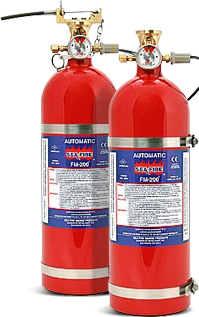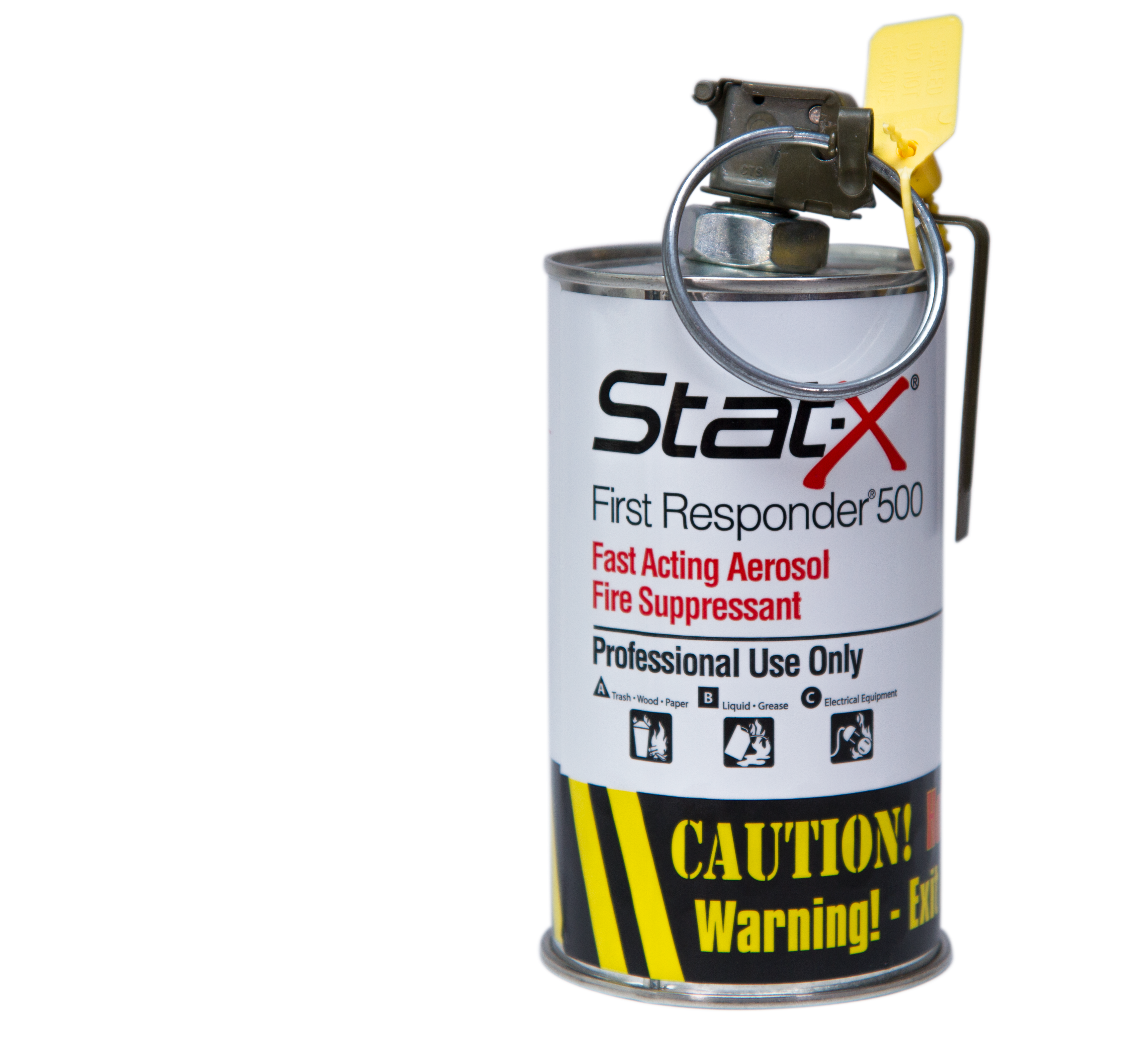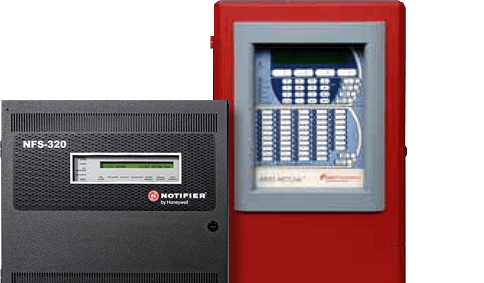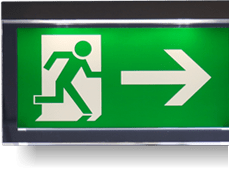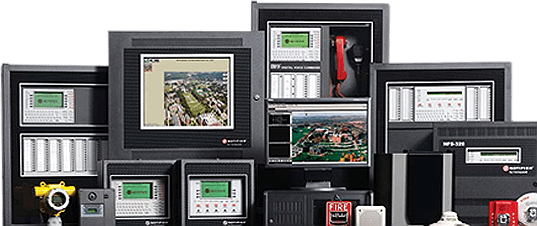Effective Exit Sign and Route Practices
Effective exit signs and routes are essential in making sure you are prepared for escape in the event of a fire, enabling you to avoid severe injuries. Fire safety is a requirement for every building - beyond merely installing fire extinguishers along walkways, however, emergency fire exits are also critical.
Effective exit signs serve as a guide for the public to navigate their way out of areas of fire to a safer place while mitigating the chaos and panic that often accompanies a fire. Therefore, effective exit signs are essential components of building fire safety, with the International Fire Code (IFC) mandating all commercial buildings to have exit signs installed that facilitate fire safety.
What Are Exit Signs & How Is an Exit Route Defined?
According to Occupational Safety and Health Administration (OSHA), an exit route is a continuous and unbarred route of exit travel from any location in the workplace to a place of safety. This means that exit routes must be easily accessible by anyone within the building, and the occupants of the building should be properly informed about the exit routes.
Explore further
A suitable layout of an exit route consists of three parts: the exit access, the exit, and the exit discharge. Exit access implies areas of an exit route that lead outside, referring to the part of an exit route that is majorly separated from other spaces, ensuring a protected travel path to the exit discharge. Meanwhile, exit discharge leads directly outside or to a walkway, street, refuge area, or open space. Finally, exit signs help identify the location of a building's exit doors, thus protecting building occupants during fires.
Why Exit Signs Are Important
1. They Help in the Identification of Exit Doors
The primary importance of exit signs is to serve as a pointer to exit doors. The many doors in a building may look alike, and without an exit sign, occupants and visitors might walk into danger zones.
2. They Serve as a Light Source in the Instance of a Power Outage During Emergencies
Exit signs also serve as a light source during emergencies. The International Fire Code (IFC) mandates every exit sign be illuminated. With illuminated exit signs, exit from a building is not carried out blindly.
Exit Sign Requirements
Various laws have been enacted to regulate effective fire exit signage in order to ensure that exit doors are effectively located during fire emergencies. For instance, employers must follow the requirements of their local Authority Having Jurisdiction (AHJ).
Other regulating authorities include the Occupational Safety and Health Administration (OSHA), the National Fire Protection Association (NFPA), the Joint Commission on Accreditation of Healthcare Organizations (JCAHO), the International Building Code, the National Building Code of Canada (NBCC), and the International Fire Code. The following are exit sign requirements as stipulated by these provisions:
- Every exit sign should be illuminated.
- Every exit marking sign must legibly reflect "EXIT" with a minimum of 6-inch high letters.
- The primary stroke of the "exit letter" should be ¾ inch wide.
- An exit sign must be placed on every exit door aside from the main exit.
- Every exit sign must be visible from the exit approach
- Exit signs shall have red letters and be placed on contrasting colour backgrounds
- For a building higher than 2 stories, all parts of the exit stair or ramp must be marked.
Exit Sign Illumination Requirements
A reliable light source must illuminate exit signs with an average of 5 feet around the illuminated surface. The surrounding light sources that provide lightning to exit signs, aside from electrically illuminated exit signs, must have discs, screens, or lenses of a minimum of 25 square inches designed with translucent materials for contrast.
Exit signs illumination requirements are provided by the National Fire Protection Association (NFPA), and include the following:
People also search
- A reliable light source should illuminate all required exit signs, including external, internal, or photo-luminescent signs.
- A minimum of 1.5 hours of emergency light should be activated if building lighting fails.
- The emergency light must reflect a minimum of 1 foot-candle light.
- If a photo-luminescent light is utilized, provision for the charging of the light must be made so that the sign will be illuminated for a minimum of 1.5 hours after the light goes off.
- Exit signs that are internally illuminated are required to adhere to the UL 924 standards.
Emergency Lighting Requirements
Emergency lighting, also known as egress lightning, illuminates and identifies ramps, stairways, hallways, passages, and exit doors to enable a safe exit during emergencies. The law requires industries, educational centers, public houses, medical centers/ hospitals, religious centers, and business buildings to include emergency lighting during emergency exit installation.
The National Building Code of Canada 2015 states that emergency lighting shall be provided in the following ways:
- Exits
- Principal routes giving access to exit in an open floor area
- Public corridors
- Underground walkways
The code further states that emergency lightning must be powered by an energy source other than the building's electrical supply. Emergency lighting must also activate automatically for a minimum of 30 minutes after a power outage.
The emergency illumination from lighting should be provided to a minimum level of 10 lx at tread or floor levels. The code also states that where self-contained emergency lighting units are utilized, they must align with the CSA C22.2 No.141, "Emergency Lighting Equipment."
The National Fire Protection Association (NFPA) states that, among other things, the highest illumination at any time must be 40 times the lowest illumination at any point to avoid unnecessary bright or dark spots.
What to Expect During the Exit Sign Inspection Process
The inspection of exit signs ensures that requirements are being followed by building managers and occupants. Exit sign inspection starts with getting an experienced inspector familiar with these requirements to confirm that you have adequately followed all relevant guidelines.
Monthly Maintenance Checks
It is not enough to conduct a one-time inspection of your emergency exit signs – there is also a need to conduct checks at regular intervals to ensure they are still as effective as they should be, especially their illumination.
Due to the possibility of wear and tear on emergency equipment, maintenance is necessary to retain its effectiveness. The following are required monthly checks:
1. Visual Inspection of the Equipment
To conduct this check, the inspector searches for exposed or loose wires and secures them. They ensure the unit is firmly mounted to the wall or ceiling to avoid casualties. Depending on the exposure of the emergency sign to damage, you may be able to attach a protective shield.
2. Functional Maintenance/Inspection
There are various ways to conduct a 30 seconds battery test: manual testing, self-testing, and computer-based self-diagnostic. Manual testing is done by pressing the push-to-test button for 30 seconds, interrupting AC power, engaging the backup battery, and observing if the illumination stays on for 30 seconds.
Self-testing is conducted for buildings with plenty of units. The push-to-test button should be pressed twice to activate the 30-second test. After 30 seconds, check the LED telltale. If it shows green, this symbolizes standard service, but if it shows red, there is a defect.
Lastly, computer-based self-diagnostic is done by activating all the testing and tracking it with a computer.
Yearly Inspections
For annual checks, a 90-minute illumination test under battery-backup power performance is required. Yearly testing checks the equipment's functionality and thus is similar to the monthly functional test.
Unlike the monthly functional check, the yearly functional test lasts 90 minutes. This test can be conducted manually or through self-testing and computer-based self-testing. The difference between self-testing under monthly and yearly maintenance checks is that for the annual 90-minute inspection, a clamp is recommended for the depression of the button for the whole 90 minutes.
Meanwhile, yearly self-testing, unlike monthly self-testing, requires that the push-to-test button be pressed 4 times for the 90 minutes of testing activation. There is no difference between monthly and yearly computer-based self-diagnostics, as there are also done by activating all the testing and tracking with a computer.
Dealing with Exit Sign Issues
The primary responsibility of building managers is to ensure, amongst other things, that their exit signs are in good condition and are pointing in the right direction. They also carry out monthly or yearly checks of their exit signs to confirm their effectiveness.
The following are some of the ways of dealing with potential exit sign issues:
1. Replace Weak Batteries to Ensure Continuous Illumination of the Exit Sign
Once your exit sign begins to appear dimmer, consider changing its batteries. To replace weak batteries, employ the services of experts to conduct further checks. You could also remove the exit sign's front panel and replace the weak battery on your own.
2. Change Bulbs That Have Burnt Out
The bulbs of the sign might have burnt out during usage and require a replacement. You can replace the bulb personally, or through the service of experts.
3. Conduct Monthly and Yearly Checks On Your Exit Signs
Ensuring your equipment functions well is essential, especially when defects go unnoticed. Consult an expert to help conduct your monthly or yearly checks.
Improper Proper Exit Sign Dangers
Exit signs and emergency exits are compulsory for commercial and industrial buildings, and the failure to install a proper exit sign doesn't just affect the owner of the building but also all of its occupants, as well as the families of those affected by casualties caused by failure.
One of the most significant dangers of improper exit signs is the risk of sanctions from the fire marshals. Sanctions may appear as a fine imposed on the erring company, or they may close down your building until the installation of the proper exit signs is complied with.
The dangers of improper exit sign installation can be life or death, and their importance can never be underestimated. At Control Fire Systems, we understand how essential it is to ensure that all of your safety equipment is working up to the standards you deserve.
Reach out to a member of our team today for help installing your fire exit signs with ease.







